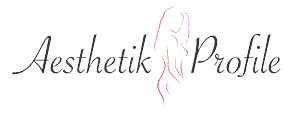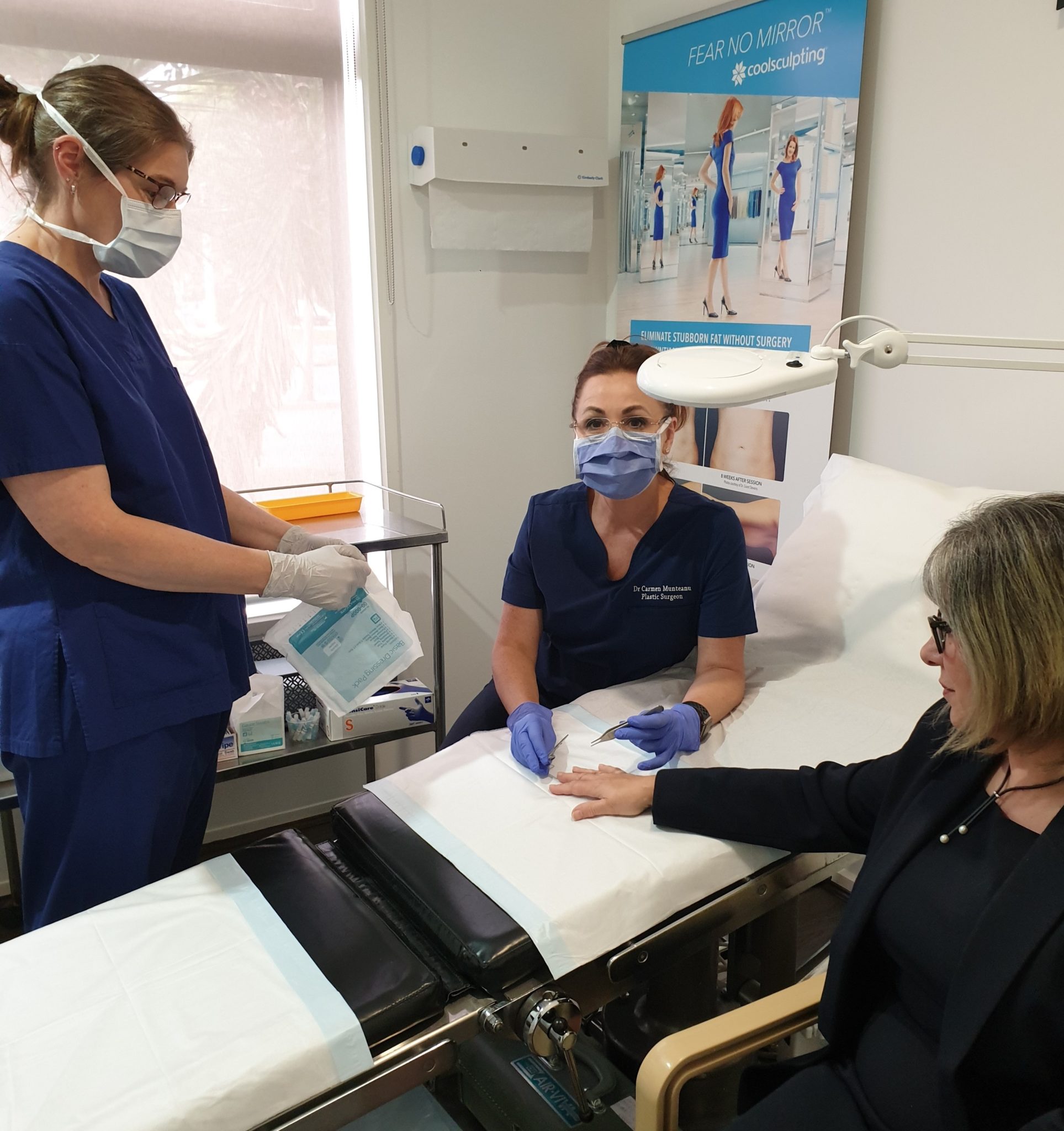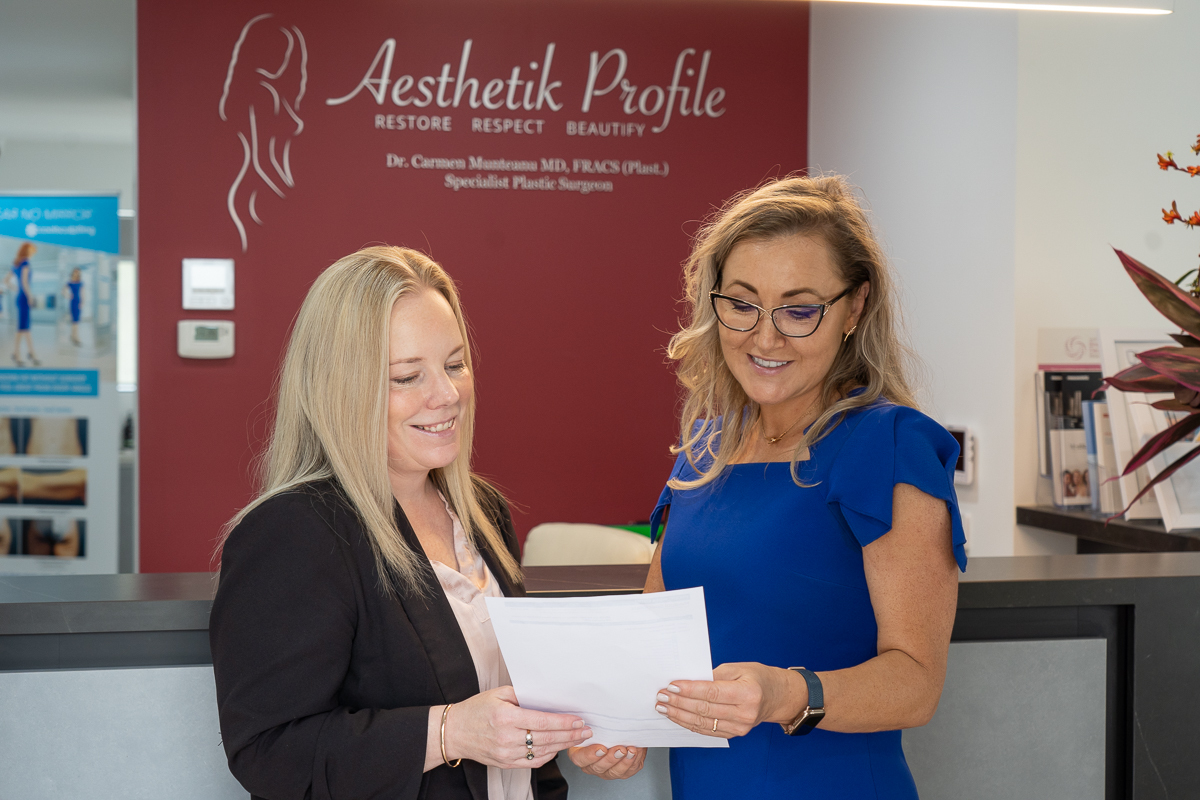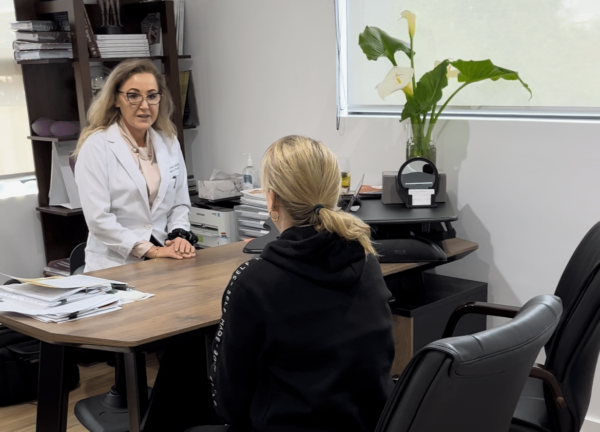Natural Breast Augmentation Surgery Using Your Own Fat – Fat Transfer to Breasts
Using Fat transfer for breast enlargement or natural breast augmentation surgery is becoming increasingly popular. Fat grafting or autologous fat transfer (AFT) can help you achieve bigger and more shapely breasts without having breast implants.
Dr Carmen Munteanu, a Female Specialist Plastic Surgeon is now offering Breast Enlargement using Fat Injections and Fat Grafting in Melbourne. During the procedure, your own fat is harvested by liposuction, processed and then carefully placed into your breast.
A Fat transfer to breast surgery is an option for any patient seeking a modest increase in the size of their breasts. Typically a half or one bra cup size increase per treatment. Multiple procedures may be required.
There are many different ways to harvest, process and inject your fat with the aim to ensure the highest survival rate of the transplanted fat and the most pleasing aesthetic outcome. The surgery is typically performed under general anaesthetic in sterile theatre conditions in an accredited hospital.
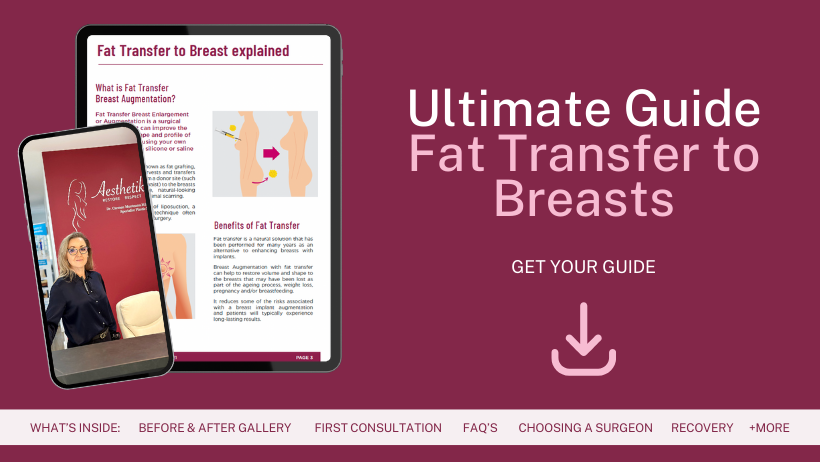
Download Dr Carmen’s Guide to
Fat Transfer to Breasts –
Natural Breast Enhancement
with your own fat
What is Breast Augmentation by Fat Transfer?
Fat Transfer or Fat Grafting is a surgical process that involves liposuction harvesting of excess body fat from one area of the body, processing the harvested fat, and then transplanting the processed fat into the breasts to increase volume or restore lost volume such as occurs post-pregnancy or with weight changes.
Am I a suitable Candidate for fat transfer?
- Good candidates for Autologous Fat Breast Augmentation want a half a cup to a one cup size increase and can maintain a stable weight.
- If you desire only a modest increase in bra cup size or a solution to minor breast asymmetry problems.
- You’ll need to have some good quality excess fat in your donor site that can be removed by Liposuction
- You’ll need to be committed to the pre-surgery and post-surgery process to maximise the amount of fat that grafts or ‘takes hold’ in your breasts
What are the Benefits of Fat Grafting Breast Enhancement?
- Increases your breast volume and shape
- Assists with matching volumes & shape of uneven or lopsided breasts – Breast Asymmetry
What are the Advantages of using your own fat for breast enlargement?
- Silicone Breast Implants are not required
- Your breasts will feel completely natural – it’s really you
- The fat removal process can help to contour other areas of your body
- It’s natural and the injected fat can improve the quality and appearance of your skin
- Less breast scarring compared to a breast implant as the fat is transferred by injection
Before and After Photos of Fat Transfer to Breast Patient
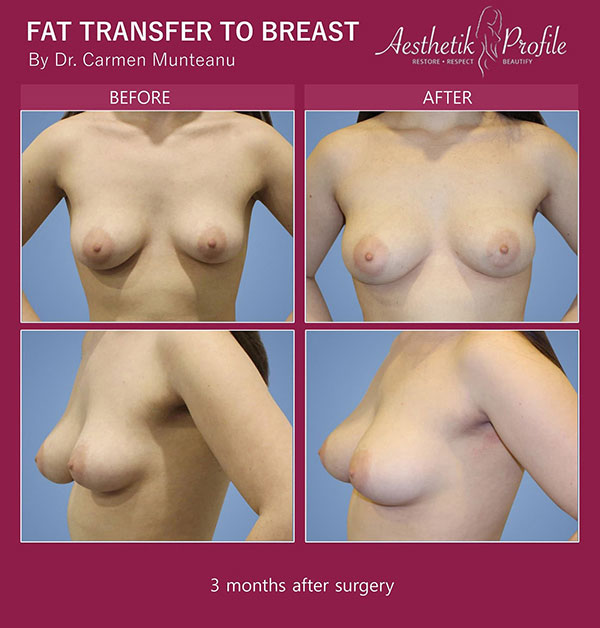
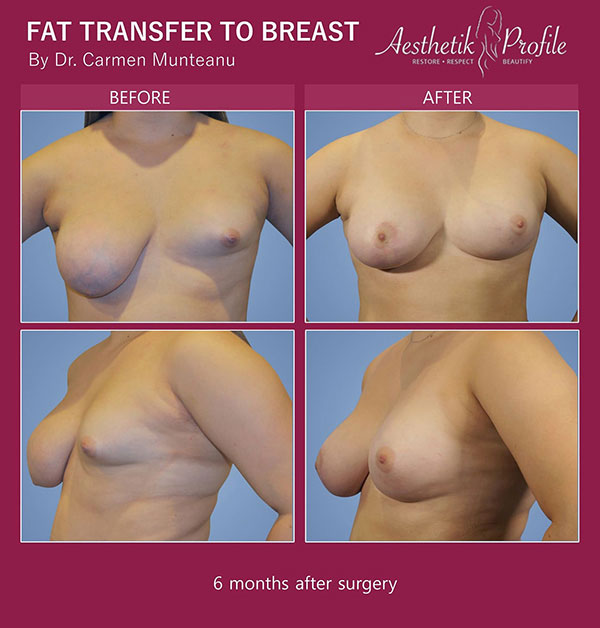
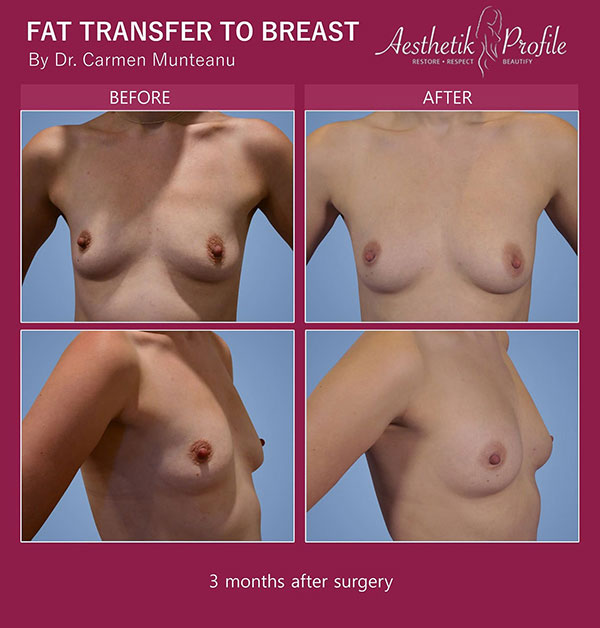
- Click here to see more real patients of Dr Carmen Munteanu’s Breast Fat Transfer before and after photos in the gallery.
The Fat Grafting Procedure – How is the Fat Transferred to the Breast?
Fat transfer is a surgical technique where fat is taken from one location via liposuction, then that fat is collected and introduced in small strands into the breast area to increase the volume or change the shape of the breast. Breast Enlargement Fat transfer can be used alone or in conjunction with other breast procedures like breast implants to create a composite or hybrid breast augmentation.
Fat is taken from your buttocks, thighs, flanks or tummy/lower abdomen and is injected into your breasts.
Breast enlargement at transfer is a delicate procedure requiring a very skilled surgeon with experience in liposuction and the fat re-injection process. Your fat is transferred as a living tissue graft and will continue to survive and thrive in the breast provided local biological conditions are suitable. However, if too much oil or under-processed fat is transferred into your tissues, the fat will not survive and uneven lumpiness or oil cysts can occur.
Dr Carmen uses a ‘closed loop fat processing system’ such as the Revolve or Pure Graft system. This has been shown to deliver fat that is of better quality in a more sterile condition and hence has a higher level of survival long term.
All surgery has risks – for detailed information about the risks and potential complications of fat transfer to breast surgery, please visit the risks of surgery page.
Recovery after Fat Grafting Breast Enlargement
You will initially have some swelling and bruising in both the donor and breast sites.
It is recommended that patients maintain a stable weight for approx 3 months after the procedure. Mild regular exercise that the patient is used to is OK to continue.
Most reliable end results of fat transfer are usually seen around 3 months after postop swelling has resided.
Should I have Fat Transfer or Breast Implants or Both?
- At this stage, fat transfer can only provide a modest enlargement of your breasts – may be one cup size per treatment.
- You’ll need to be realistic about the possible outcomes and multiple procedures may be required to get your desired breast volume increase.
- This may NOT be the right surgery for you and you may still need breast augmentation with implants or breast lift surgery to get the look you want.
How to find the best Fat Transfer Surgeon in Melbourne
Always choose a specialist plastic surgeon that has experience in your desired procedure. Make sure you check the AHPRA and ASPS websites to ensure they are really a plastic surgeon. Ask to see their before and after pictures of patients.
Artistic skill, experience and good judgement are needed to avoid complications and to achieve an optimal fat transfer result.
How much is the Fat Transfer to Breast Procedure – Prices & Costs of Fat Grafting
The cost of fat transfer is similar to that of breast augmentation using a breast implant.
All Surgery is customised and Dr Carmen’s team will give you a price for your Breast surgery that will depend on the exact type of procedure you require, the hospital you attend and the length of your stay.
After your initial consultation, you will be given a detailed quote. This will include the Surgeon’s fee, Anaesthetist fee, Surgical Assistant fee and the hospital fees.
We can also provide information on Payment Plans, Finance, Private Health Insurance and different methods of payment.
Fat Transfer FAQs
Further Reading – Medical References
- American Society of Plastic Surgeon page on Fat Transefer in Breast Augmentation surgery
- BPS- The Pros and Cons of Fat Transfer Breast Augmentation
- Plastic and Reconstructive Surgery- Safety Profiles of Fat Processing Techniques in Autologous Fat Transfer for Breast Reconstruction
- British Journal of Hospital Medicine- Autologous fat transfer for breast surgery
Planning your Breast Surgery
There are many options when it comes to breast surgery. Every option requires careful and individual planning to ensure it is the correct choice for your desired outcome. Each and every option has its advantages and disadvantages which need to be addressed and understood before you proceed with your surgery.
Dr Carmen offers breast procedures which are anatomy-based; she strongly believes the most natural appearance is ideal for her patients. Further to this, while you may have your own ideas about your ideal cup size, the dimensions of your body, specifically the width of your rib cage underneath the breast and your shoulder frame are the main determinants of the maximum size of fat transfer which is feasible for you to receive.
During your consultation, Dr Carmen will carefully listen to your concerns and expectations, as well as discussing your reasons for surgery, health history, and risk factors. Your diet, exercise, personality, body frame and quality of your breast tissue are also factors which will need to be taken into consideration.
After conducting a comprehensive medical examination, Dr Carmen will advise you of the options she feels are best suited to your individual case. She will also further discuss the expected results, and recommend a treatment plan, from the preparation stage through to the aftercare.
